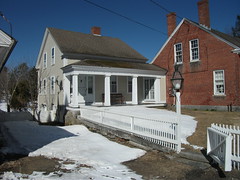The stereotypical image of a homeless person is usually portrayed in a highly urbanized setting. Just as population is spread across the country, filling both urban and rural niches, so is the chronic problem of homelessness. Small towns and the countryside have more than their fair share of people sleeping rough, and sleeping rough at this time of year can be deadly.
Look at Cheshire County, New Hampshire. Homelessness is a rising problem, fueled by many factors. For one thing, according to Chris Sterndale, executive director of Cross Roads House, the state and local budgets have cut back extensively on mental health funding. The effects can be seen not only in rising homeless numbers but also in a rise in the proportion of them suffering mental illness. Ten years ago the mentally ill comprised one-third of the homeless population, not its one-half.
The biggest factor is hardly surprising – economics. The New Hampshire Union Leader reports:
Overall, though, mental illness is not the driving cause of homelessness; low wages mixed with the lack of affordable housing are the biggest factors.
“In many cases, it’s the working poor. Just because they don’t have a place to sleep this month, it doesn’t mean they are that much different from the other low-income people around us,” Sterndale said. “A lot of these are families that have young kids, and if you can’t earn enough for rent, child care and transportation, something’s gonna give.”
Housing costs in the Seacoast area have only gone up despite the recession, he said. “In a lot of places around the country, rent came down as we went through this first part of the recession, but that didn’t happen here.”
After the Seacoast area, Nashua has the highest rent prices in the state, Brady said, because of its proximity to Massachusetts.
People working in the Bay State who are making higher wages move into Nashua for the lower cost of living compared with that in Massachusetts, pushing the working poor out of housing.
On top of that, northern New Hampshire residents are moving to the area looking for work.
These are not the type of concerns that come immediately to mind when most people think about homelessness, but they are still valid. Every child, every person, left without shelter in the snow is important.
The texture of the problem changes from community to community, although many things remain constant. For instance, rehabilitative approaches are proven effective, and with the rising percentage of mentally ill among New Hampshire’s homeless they make an obvious tactic to embrace. Even so, most of the affected rural areas lack the density of resources larger cities possess.
None of the problems we seek to address is simple. Each one exists in a complex web of community, economic factors, and opportunity. While we seek big picture solutions we also need to keep in mind that each area has slightly different needs, requiring that those approaches be tailored on the local level in order to achieve maximum effect.
Related articles
- Half of People Shot by Police Are Mentally Ill, Investigation Finds (alternet.org)
- Bitter cold is dangerous for some (wmur.com)
- Unemployment and Poverty in America: 75 Economic Numbers From 2012 That Are Almost Too Crazy To Believe (consciouslifenews.com)
- America’s Mental Health Crisis (huffingtonpost.com)





















